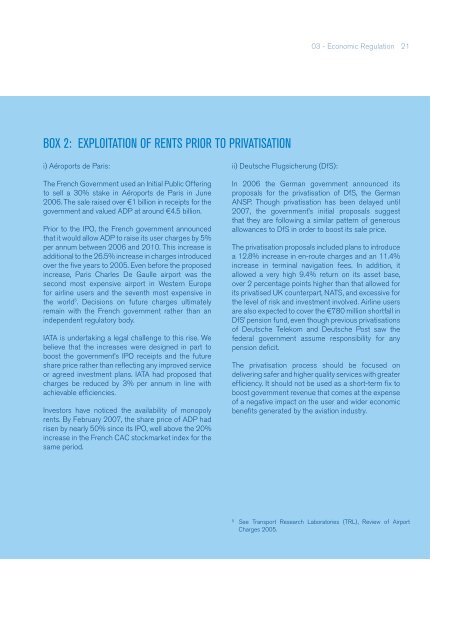Economic Regulation - IATA
Economic Regulation - IATA
Economic Regulation - IATA
Create successful ePaper yourself
Turn your PDF publications into a flip-book with our unique Google optimized e-Paper software.
03 - <strong>Economic</strong> <strong>Regulation</strong> 21<br />
BOX 2: EXPLOITATION OF RENTS PRIOR TO PRIVATISATION<br />
i) Aéroports de Paris:<br />
The French Government used an Initial Public Offering<br />
to sell a 30% stake in Aéroports de Paris in June<br />
2006. The sale raised over €1 billion in receipts for the<br />
government and valued ADP at around €4.5 billion.<br />
Prior to the IPO, the French government announced<br />
that it would allow ADP to raise its user charges by 5%<br />
per annum between 2006 and 2010. This increase is<br />
additional to the 26.5% increase in charges introduced<br />
over the five years to 2005. Even before the proposed<br />
increase, Paris Charles De Gaulle airport was the<br />
second most expensive airport in Western Europe<br />
for airline users and the seventh most expensive in<br />
the world 5 . Decisions on future charges ultimately<br />
remain with the French government rather than an<br />
independent regulatory body.<br />
<strong>IATA</strong> is undertaking a legal challenge to this rise. We<br />
believe that the increases were designed in part to<br />
boost the government’s IPO receipts and the future<br />
share price rather than reflecting any improved service<br />
or agreed investment plans. <strong>IATA</strong> had proposed that<br />
charges be reduced by 3% per annum in line with<br />
achievable efficiencies.<br />
Investors have noticed the availability of monopoly<br />
rents. By February 2007, the share price of ADP had<br />
risen by nearly 50% since its IPO, well above the 20%<br />
increase in the French CAC stockmarket index for the<br />
same period.<br />
ii) Deutsche Flugsicherung (DfS):<br />
In 2006 the German government announced its<br />
proposals for the privatisation of DfS, the German<br />
ANSP. Though privatisation has been delayed until<br />
2007, the government’s initial proposals suggest<br />
that they are following a similar pattern of generous<br />
allowances to DfS in order to boost its sale price.<br />
The privatisation proposals included plans to introduce<br />
a 12.8% increase in en-route charges and an 11.4%<br />
increase in terminal navigation fees. In addition, it<br />
allowed a very high 9.4% return on its asset base,<br />
over 2 percentage points higher than that allowed for<br />
its privatised UK counterpart, NATS, and excessive for<br />
the level of risk and investment involved. Airline users<br />
are also expected to cover the €780 million shortfall in<br />
DfS’ pension fund, even though previous privatisations<br />
of Deutsche Telekom and Deutsche Post saw the<br />
federal government assume responsibility for any<br />
pension deficit.<br />
The privatisation process should be focused on<br />
delivering safer and higher quality services with greater<br />
efficiency. It should not be used as a short-term fix to<br />
boost government revenue that comes at the expense<br />
of a negative impact on the user and wider economic<br />
benefits generated by the aviation industry.<br />
5<br />
See Transport Research Laboratories (TRL), Review of Airport<br />
Charges 2005.

















